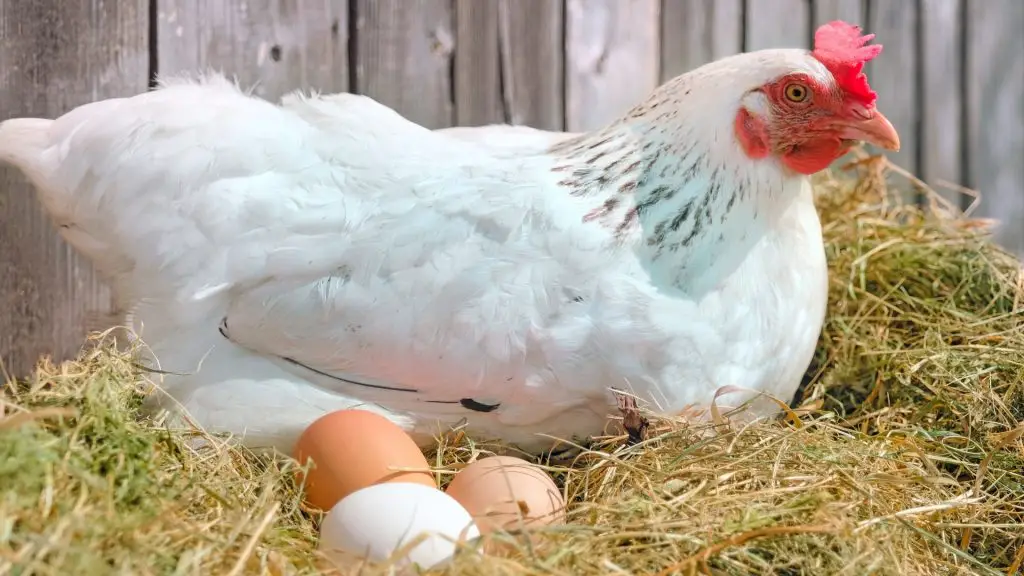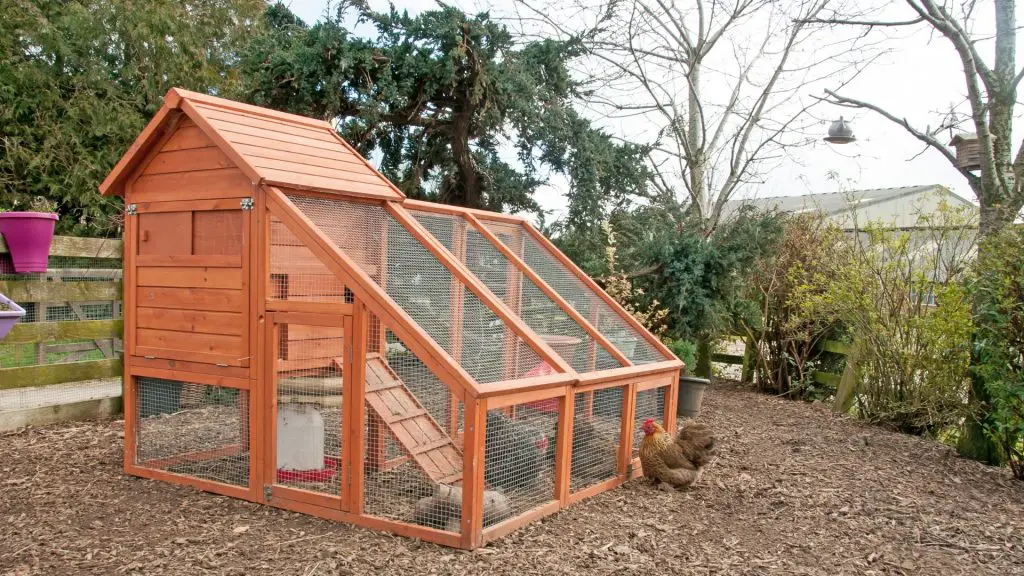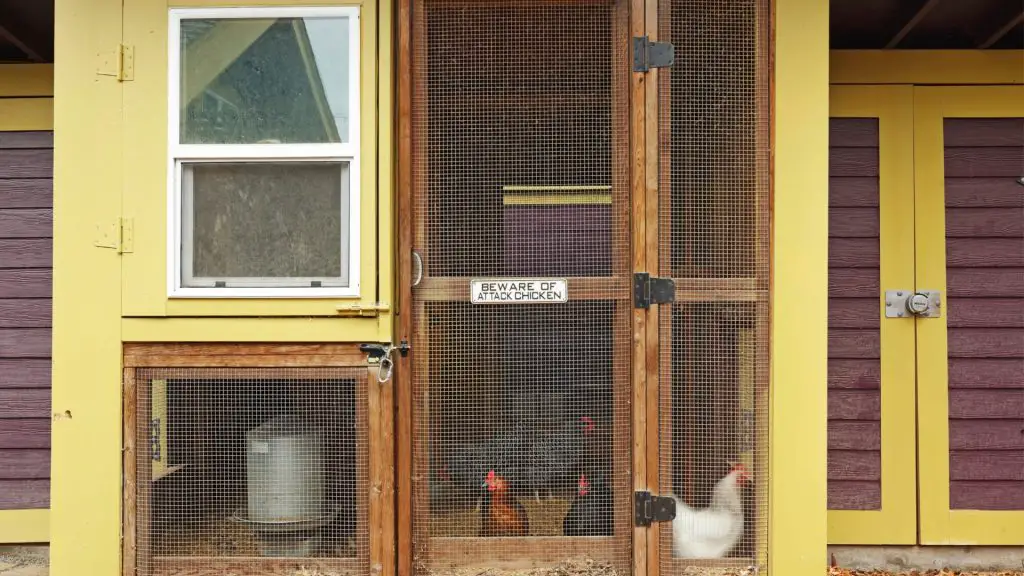A chicken coop protects your poultry from the outside elements, predators and provides a comfortable place for them to roost and lay eggs safely.
What should be inside a chicken coop? A good chicken coop needs artificial light during the winter (if you have limited access to daylight), solidly constructed walls and roof, a chicken run, roosting boxes, good ventilation, nesting boxes, and food and water containers. How you decorate your chicken coop is up to you.
This article will take a deeper look at what should be inside your chicken coop, so keep reading.
What Kind of Light for Chicken Coop?

Chicken coops generally don’t need artificial light unless you live in an area where the days are very short during the winter. A light on a timer switch for the early mornings and evenings can help counteract the lack of natural light and keep your chickens producing eggs year-round.
This is essential if there are less than 14 hours of daylight in your area.
Use of Sunlight for Egg Production

When there’s a lack of sunlight, the chicken’s pituitary gland will signal the ovaries, instructing them not to release an egg. During this time, your chicken will therefore not lay eggs. That is why it is essential to ensure your chicken coop has access to enough sunlight.
An added benefit to keeping a light on during the night is that it warms the coop, keeping the chickens, eggs, and chicks warm.
The Red Light Argument
Lighting a chicken coop with a red globe is thought by some chicken owners to have a calming effect on their poultry.
These claims, however, remain unproven, and it’s often down to the chicken owner to experiment with the effect of red light on their chickens.
It’s worth noting that chickens do not perceive red light as the same as daylight. If you need to provide more light for your chicken coop during the winter, you would need to supplement the red light with a regular color globe.
Basic Items for a Chicken Coop
Chicken coops don’t need to be extravagant or expensively made. As long as they contain a few basics, your chickens will thrive and lay plenty of eggs.
Basic elements of a chicken coop include:
- 4 sturdy walls and a strong roof. This is to ensure your poultry remains comfortable, regardless of the weather. Good ventilation is also essential, but any ventilation holes or windows should have screens to prevent rodent infestations. Try and position the ventilation holes away from the roosting boxes as chickens do not like a draught.
- Roosting boxes. Like all animals, chickens need a cozy place to sleep. Consider an elevated nesting box as chickens feel safer above the ground. Chickens also use roosting boxes to lay eggs, and these should therefore contain straw to cushion and protect eggs. Traditionally, roosting boxes were covered with curtains or burlap bags for added privacy, comfort, and warmth.
- Chicken run. This is the enclosed, outdoor area immediately surrounding the coop. It allows the poultry to roam around without being vulnerable to predators. This is also a good place for food and water.
- Nesting boxes. Your chickens will lay their eggs safely, securely, and privately in these boxes. These can make collecting eggs easier and prevent chickens from stomping or destroying the eggs, which can happen if the eggs aren’t kept in a secure, cushioned area.
- Food and drink containers. It’s best to keep them in the chicken run surrounding the chicken coop as water can make the air inside the coop too humid. When roosting for the night, chickens usually sleep soundly and won’t get up to eat, so there’s no need to keep the food in the coop. The only exception will be if you’re worried about the water freezing outside overnight.
Optional extras include a litter tray underneath the roosting area because chickens defecate while sleeping, and litter trays make cleaning much easier.
Hanging feeders suspended above the ground also help prevent messes while eating.
Related: What to Feed Backyard Chickens? | Information and Facts
How to Decorate a Chicken Coop?

There are many ways to decorate a chicken coop. Some chicken owners prefer to leave the coop plain and unpainted and only include straw in the roosting area, water containers, and a feeder. Others like to decorate their chicken coops so that they’re attractive features in their backyard or farm.
Popular decorating ideas for chicken coops include:
- A country cabin. This features raw and unpainted wooden walls, windows decorated with gingham or floral curtains, and traditional decorations, such as pot plants or a simple painting.
- Plain farmhouse-style chicken coops. These are painted glossy white with the door handles and other fixtures a contrasting black. The look is completed by adding a wooden gable or lattice below the roof. This is a great choice if you live on a farm or in the countryside.
- A cute cottage. You can create a quaint cottage look by painting the outer walls a cheerful color (such as bright red or yellow). Finish it off by hanging some flower baskets from the roof or making an old-fashioned sign above the door.
- Minimalist white with spots of color inside. This is a more contemporary look for a chicken coop. The entire coop has plain features and is painted entirely white, except for a few key places with bright colors (painting the individual chicken roosting spots with a different color is a great idea). This look creates a bright and cheerful look for a chicken coop.
- Plain but functional. If you prefer an uncomplicated chicken coop style, consider whitewashing the interior walls and hanging some vintage egg baskets for an elegant look that is also functional.
Should I Paint the Inside of My Chicken Coop?

You should paint the inside of your chicken coop as it can make your coop look good and protect it from the elements, making it more durable and long-lasting. However, you should only use non-toxic paint to preserve the health of your flock. The paint must dry properly, too.
Also, ensure that the coop is well-ventilated if any harmful fumes remain.
Painting the inside of your chicken coop can deter insects and prevent splinters in your chicken’s feet.
Tips for Painting the Inside of a Chicken Coop
- Use of Non-toxic chalk paint. This is an excellent option for painting the inside of a chicken coop. It’s inexpensive, has hardly any smell, and comes in a wide range of cheerful colors.
- Paint the inside of the coop. This is preferable than leaving the wood raw as it makes the cleaning process more manageable. You can simply wipe any messes off the smooth, painted surface.
- Learn how to utilize raw, unpainted wood. It can absorb liquid chicken waste, making the coop unhygienic and smelly.
- Paint the floor. This makes sweeping out the coop much more manageable, too.
- Paint the outside of the coop. As mentioned earlier, paint can extend your chicken coop’s life. Painting the outside will protect chickens from the elements. For maximum protection, consider a durable gloss paint that can withstand rain, sun, and wind well.
What Color to Paint Inside of Chicken Coop?
What paint color you wish to use for your chicken coop is entirely up to you. However, lighter colors help with light reflection and distribution more effectively. White is an excellent choice, but pastel shades (such as pale pink, blue or green tones) also work well.
Darker colors will absorb light, but if you like a darker shade, this can be solved by having a light on permanently.
Chickens don’t see color, so the paint won’t benefit them, but it’ll be a good view for you or anyone visiting the coop.
To create a more homely and comforting atmosphere for the chickens, consider complementing the light colors with tan-painted roosting boxes, which would give off the perception of warmth.
Related: Where to Buy Chicken Coops? | Check Before Buying!
